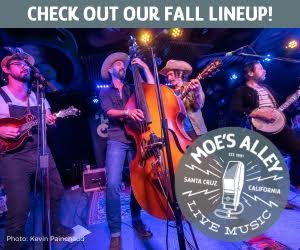 A local project collects and shares the tales of Central Coast gleaners
A local project collects and shares the tales of Central Coast gleaners
The roots of gleaning run deep in the story of humankind. The tradition of collecting crops leftover after a harvest is mentioned throughout the Bible, early cultures promoted gleaning as a form of welfare (the peasants could visit fields after the harvest to take what would otherwise go to waste or be ploughed over), and it was a legal right for cottagers in England as recently as the 19th century.
Today, gleaning has come to include dumpster diving, collecting food from grocery stores and restaurants, taking fruit from abandoned trees, and even non-food related activities, like gathering discarded materials to make art, or the collecting of stories.
The Gleaning Stories project began in mid-2008 as an effort to garner the oral histories of Central Coast gleaners. The seed was planted for Rusten Hogness, a Santa Cruz radio producer, and his wife Donna Haraway, a history of consciousness professor at UC Santa Cruz, when they saw a French documentary titled “The Gleaners and I.” “We loved that film, and we were already interested in food and culture, politics and hunger, and food and justice,” remembers Haraway. The couple connected with Ag Against Hunger, a local organization that spearheads large year-round gleans, assembled a team of colleagues, and set out to glean both crops and the stories of those who volunteer to collect them.
Gleaning Stories, found at humweb.ucsc.edu/gleaningstories, now has more than 80 stories from named gleaners, a dozen longer interviews, and countless sound bites from the field. On Nov. 15, the project celebrated more than a year of success with “The Gleaners: A Harvest of Stories,” an exhibit at the National Steinbeck Center in Salinas.
Why Glean?
For a country that produces more food than any other, the United States is home to a surprising number of hungry people. More than 49 million Americans are at risk of hunger, according to a United States Department of Agriculture report released on Nov. 16. This number is up 36 percent from last year, largely due to the economic recession and record unemployment rates. Five million Californians are hungry or are at risk of hunger, according to the California Food Policy Advocates.
“You can’t not have a little thread in your consciousness of what real farm labor is actually about and the difference between having to do it for a living and doing it as a community service operation.”—donna haraway
And in the agricultural breadbasket that is Central California? One in five families are food insecure, according to Ag Against Hunger Executive Director Abby Taylor-Silva.
Taylor-Silva also says that local food banks have seen a 30 to 50 percent increase in demand in 2009. As a result, Ag Against Hunger, which collects food from growers and shippers and distributes it to food banks, has also been busier. They expect to collect over 10 million pounds of food this year and reach 75,000 people on the Central Coast—according to Taylor-Silva, Santa Cruz accounts for half of that.
Ag Against Hunger’s primary mission is to serve as the “necessary link” between agriculture and food service organizations, but they have also been responsible for the burgeoning Santa Cruz County gleaning movement. There were 70 volunteers who gleaned for Ag Against Hunger when Taylor-Silva came on board four years ago; now, there are over 600 volunteers and 15 growers who participate.
“A couple of months ago we realized we were having over 100 people at gleans, so we began holding gleans every week instead of every other week,” says Taylor-Silva, adding that the swelling number of volunteers can also be attributed to a boom in food awareness. “We are trying to keep up with the interest.”
Haraway and Hogness also see an upward trend of food consciousness—on the field and off. “There is no question among the students I work with—graduate and undergraduate—and faculty that there is a lot more [food] awareness,” says Haraway. Part of this awareness, they say, is recognizing the inequalities of food systems and taking tangible steps to address them, like gleaning. “[The gleaners we talk to] are people who are happy because they are doing something that is meaningful,” says Hogness. “It’s making a difference by addressing something that they know is an injustice.”
Although gleaning accounts for only 1 to 2 percent of the food Ag Against Hunger distributes every year (the rest is donated by growers and shippers), they encourage it because it allows the community to get involved.
“The gleaning is an added benefit,” says Taylor-Silva. “It is bringing in some diverse products and giving the community an opportunity to add to it. The people are of all ages, work in all sorts of jobs, and we find a lot of them really enjoy coming out for a few hours, helping their community, learning a little bit about agriculture and staring their weekend off that way.”
Assemblymember Bill Monning, who participated in an Ag Against Hunger glean on Oct. 24, says that gleaning is “win win.” “It represents a very valuable collaboration among agriculture, the community volunteers and the needy,” he says.
The Gleaning Stories project is blossoming along with the gleaning movement. Their website has expanded immensely in its first year, and they hope to help arrange further gleans in Santa Cruz and more urban areas, and to recruit more organic growers. They also plan to build an instructional story project “cookbook” on their website where anyone interested can learn how to begin their own story collection.
Why Tell Stories?
Before diving in to the nuts and bolts of American factory farming in his new book “Eating Animals,” author Jonathan Safran Foer writes, “We are made of stories…we are not only the tellers of our stories, we are the stories themselves.”
It was in this light that project members began Gleaning Stories: they wanted to collect the oral histories of gleaners to tell a larger story, one of generations and what is passed between them, of community, of complexity and of commonality. “When you listen to these stories and look at the pictures, you get the sense of the diversity of your community, but also the connections,” says Haraway.
Marco Harding, a 16-year old Santa Cruz High student, began going on gleans last year. In his story, we hear about his first glean, his initial reluctance and, later, his reasons for continuing to glean and what he has learned from it. “You’re driving on the road and you see the fields of people—that is one perspective, but when you are in the field, you are in the place of the workers watching the cars go by, and it’s a different perspective of that same field,” he says. “It’s like you are in two people’s bodies at once.”
Hogness, who records and edits the interviews, says that this new understanding is one of the over-arching themes in the gleaning stories. Haraway adds that although gleaners are trying fieldwork for themselves, it’s different in that it is recreational and for short periods. “You can’t not have a little thread in your consciousness of what real farm labor is actually about and the difference between having to do it for a living and doing it as a community service operation,” she says. Other themes in the stories are increased agricultural awareness (after cutting a few heads of lettuce, for example, people say they will think of food at the grocery store differently), and waste. “They are blown away when we go into a field and see how much waste there is [or would be],” says Hogness.
Personal growth is another thread that weaves throughout the stories. Hogness’ sister, Suze Rutherford, first became involved with Gleaning Stories as a sponsor. She has since flown down from her home in Seattle to participate in two gleans, and says that those two Saturdays alone have changed her life. “I…yearned for a community that shares stories and does work of that depth,” she says. “Every Saturday made a difference in my life; so one of the things I learned was that I need to change my life so that I can be a part of that.
“It feels good on the heart level,” she adds. “It’s satisfying—just as satisfying as sharing a meal with a group of friends.”












